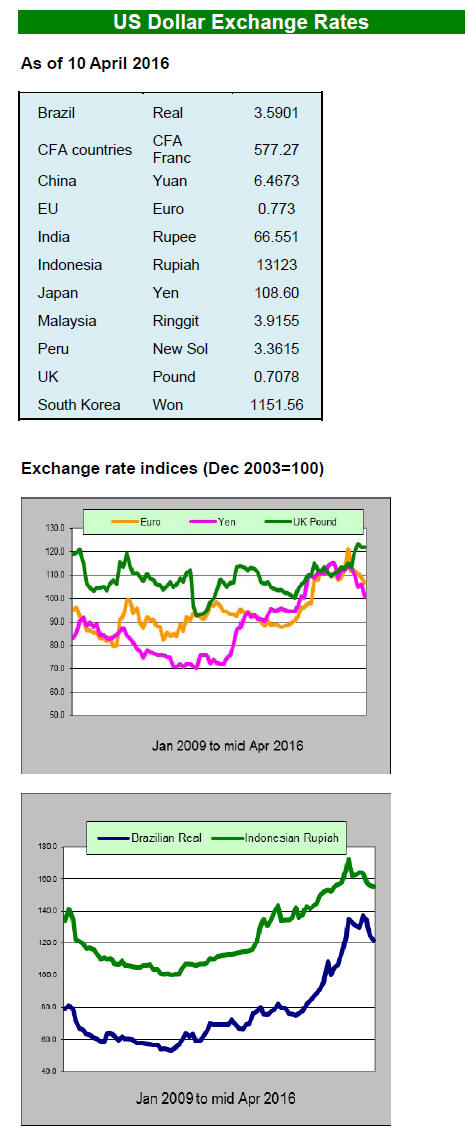2. GHANA
Sawnwood dominated 2015 export performance
The Timber Industry Development Division (TIDD) has
released its Timber Export Report for the first 10 months
of 2015. During the period January to October 2015 a total
of 229,207 cubic metres of wood products were exported
earning Euro 151.91 million.
Sawnwood, comprising kiln dried (approx. 40%) and
airdried
(17%) accounted for the bulk of exports to
international and regional markets.
Exports of sawnwood (57%), plywood (14%), billets (8%)
and sliced veneer (5%) together accounted for over 80% of
total exports, the balance was distributed over a further ten
wood products.
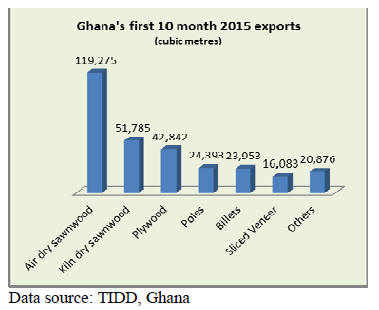
Between January and October the export of poles and
billets accounted for 16% of the total export volume
compared to 14% in 2014, earning Euro 13.64 million.
Secondary products comprising sawnwood, plywood,
veneer, boules, briquettes and kindling accounted for 80%
of the total export volume (compared to 82% in 2014) and
earned Euro 133.63million.
Finally, tertiary products comprising moulding, dowels,
furniture parts and flooring contributed around 4% of the
total export volumes, slightly up on 2014 and earned Euro
4.63million.
The top species utilized were teak, rosewood, ceiba, wawa
and gmelina.
In the period of the TIDD review Ghana¡¯s primary
products were shipped mainly to Asian markets (58%),
regional African markets (19%), Europe (14%) and
America (4%).
Short-term prospects for increasing production in Ghana
are not bright. Many producers are operating well below
capacity because of a shortage of raw materials and power
outages.
Manufacturers complain of rising production costs due to
high utility prices, tax increases and high interest rates.
Over the past 12 months there have been several mill
closures which is adding to the unemployment situation.
Boost for science and technology
The Council for Scientific and Industrial Research (CSIR)
has establish a College of Science and Technology
(CCST) enabling it run various programmes and research
at the graduate level.
The aim is to offer training that would lead to the
efficient
management of natural resources in the West African subregion.
New governor for Bank of Ghana
Dr. Abdul Nasiru Issahaku has been appointed as the new
governor of the Bank of Ghana (BoG). His appoint
became effective in April this year. The appointment
follows a decision by the previous governor, Dr. Kofi
Wampah, to take an early retirement. Dr. Issahaku served
as the second Deputy Governor of the BoG before his new
appointment.
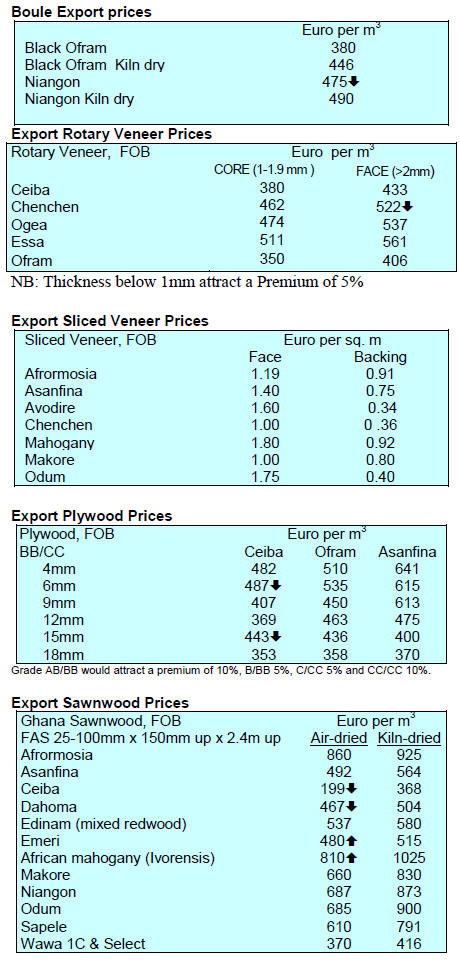
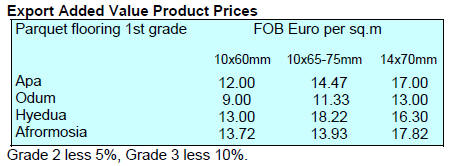
3. MALAYSIA
2015 export performance
The Malaysian Timber Industry Board (MTIB) and the
Department of Statistics has released national wood
product export data for 2015.

SIRIM suspends certification for Kelantan State
FMU
The Forest Management Certificate issued to the Kelantan
State FMU (FMC 005) against the requirements of
Malaysia¡¯s Criteria and Indicators (MC&I, Natural Forest)
was suspended as of 11 March 2016.
This decision came after the Kelantan State failed to close
a major Corrective Action Request (CAR) for the FMU
following a second surveillance audit by SIRIM QAS
International.
Consequently, all logs sourced from the Permanent
Reserved Forests (PRFs) in the Kelantan State FMU after
11 March 2016 will not be recognised as PEFC certified
under the Malaysian Timber Certification Scheme
(MTCS).
Nevertheless, logs originating from Kelantan State FMU
can be accepted as PEFC Controlled Sources, provided
that a due diligence system has been implemented and that
the logs are not sourced from conversion areas.
This is the second suspension in Malaysia after the
certificate to the Johor State Forest Management Unit
under the MC&I (Natural Forest) was suspended from 1
January 2016.
Forest Research Institute of Malaysia to expand
support to industry
The Forest Research Institute of Malaysia (FRIM) was
provided with a budget of RM13.34 million (approx.
US$3.41 million) this year to spur research and
development in support of the timber industry.
A new Bill is expected to be tabled during the next sitting
of Parliament to expand the functions of FRIM allowing it
to become more involved in timber industry research,
development and commercialisation.
In related news the Ministry of Natural Resources and
Environment has allocated RM 25.99 million (approx.
US$6.65 million) for projects on forests rehabilitation and
preservation in Peninsular Malaysia for the current
financial year.
New Wildlife department for Sarawak
Sarawak Chief Minister, Adenan Satem, has proposed
establishing a Wildlife Department to enhance efficiency
in the conservation of wildlife. Currently in Sarawak
wildlife management is the responsibility of the Forestry
Department.
The Sarawak State government has targeted six million
hectares of land in the State as permanent forests and one
million hectares as totally protected areas (TPAs). To-date
the state has 4.35 million hectares or 72.5% of the State
land permanent forests and 0.85 million hectares as TPAs.
Sarawak companies to secure initial certification by
2017
To sustain State forest resources the Chief Minister of
Sarawak said the target is to have the six major timber
companies in the state have at least one of their Forest
Management Units (FMU) certified by an accredited
certification body by 2017.
To-date 33 forest timber licensees with an area of about
2.5 million hectares have indicated their intention to be
certified. As an incentive, 60-year tenures will be granted
for certified areas.
4. INDONESIA
Re-evaluation of SVLK exemptions
Indonesia¡¯s Minister of Trade has said his ministry was reevaluating
its policy on the SVLK.
The current Regulation No. 89 / M-DAG / PER / 10/2015
on the export of wood products allows certain products to
be exported without being certified. The rationale behind
this was that up-stream production (logs and sawnwood
for example) were already certified.
The Minister said the re-evaluation was being undertaken
because overseas buyers of Indonesian wood products
prefer to import V-legal wood products which satisfy
import regulations in their own countries.
News of the re-evaluation of the trade ministry regulation
exempting some products from SVLK certification
brought a sharp response from furniture and handicraft
industries.
The Association of Indonesian Furniture and Handicraft
(AMKRI) has said it will reject any revision of the trade
regulation saying such a move will be detrimental to the
interests of downstream product manufacturers.
The Association reasons that it is just too costly for most
enterprises to obtain SVLK certification and that they
cannot pass on the high costs to buyers.
The re-evaluation will determine the pros and cons of the
current regulation and a quick decision seems likely.
Cut in corporate tax to stimulate investment
Stimulating domestic investment and attracting foreign
investment in the wood processing sector is a major aim of
the government. In support of this aim Indonesia plans to
lower corporate taxes by 5% to 20%.
A 20% tax rate is considered a very competitive rate and
in line with rates in other ASEAN countries. Eventually
the rate will be cut to 17.5% according to government
statements.
Growth depends on continued reform
The latest ¡®East Asia and Pacific Economic Report¡¯ from
the World Bank forecasts that Indonesia could achieve a
5.1% growth in 2016. This could rise to 5.3% in 2017 if
the government continues with its efforts to reform the
economy.
World Bank economist, Sudhir Shetty, said the country
has an ambitious programme and packages of support
which should lead to higher investment. However, the
forecast growth for the Indonesian economy is lower than
in the Philippines and Vietnam where growth could top
6% annually.
To-date the Indonesian government has announced a
swath of reforms aimed at facilitating and simplifying
procedures for both domestic and foreign investors.
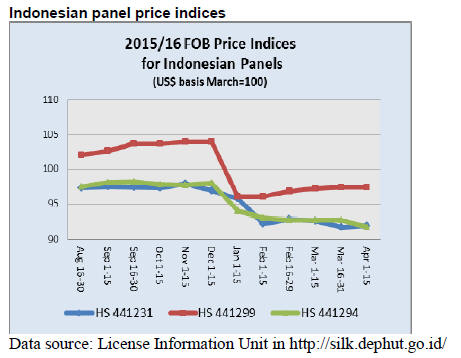
5. MYANMAR
Annual Allowable or Approved cut?
According to private sector sources MTE will harvest
15,000 cubic tons of teak logs and 500,000 cubic tons of
hardwood logs this year. Analysts note that a new term
¡®Annual Approved Cut¡¯ has been introduced and that the
tonnage mentioned is below the Annual Allowable Cut of
18,000 cubic ton for teak.
However, there has been no official statement from MTE
on this new terminology. In Myanmar, AAC has been
understood as Annual Allowable Cut for many years so
this is the first time Annual Approved Cut (AAC) has been
mentioned.
Teak and hardwood sales suspended for New Year
MTE will not hold any sales in April because of Thingya
celebrations. Thingyan, which means "transit of the Sun
from Pisces to Aries¡± is Myanmar¡¯s New Year Water
Festival and is celebrated in mid-April (the Burmese
month of Tagu). Thingyan is a Buddhist festival celebrated
over a period of four to five days, culminating in the New
Year.
More calls for logging ban
Irrawaddy Online Media have reported a press conference
called by ALARM, a domestic NGO. At the event, Oliver
Springate-Banginski, a faculty member of the University
of East Anglia, UK, whose primary research interest is the
political economy/political ecology of forest governance
reform in developing countries, urged the government to
introduce a logging ban because of the extent of
deforestation and forest degradation.
According to ALARM, within Myanmar¡¯s Permanent
Forest Reserve of 174,000 square kilometres (2014), prime
forest occupies 27%, ¡®poor¡¯ forest at 55%, another 15%
has no forest cover. A further 2% is plantations with the
balance being rivers and lakes.
The Chairman of ALARM, Win Myo Thu, urged the new
government to introduce a system of forest monitoring in
which ordinary people can participate.
A report from ALARM recommends upgrading the
capacity of the Forestry Department, eliminating the
Myanma Timber Enterprise (MTE) and State Owned
Enterprises and establishing a timber legality monitoring
system.
Myanmar has started work on forest certification and a
working group will launch a TLAS Gap Analysis with
assistance of the EU FLEGT Facility and FAO.
6.
INDIA
Plywood market outlook report
Late last year Businesswire released a report ¡®India
Plywood Market Outlook to 2019 - Increasing Households
and Rising Commercial Space to Shape Future Growth¡¯
which offers an analysis of the plywood market in India.
The report covers various aspects such as plywood market
size, segmentation on the basis of organised and unorganised
sector, regional demand and distribution
channels and types of plywood in demand.
The report offers and analysis of the plywood market in
India looking at drivers and restraints to growth,
government regulations, trends and developments, the
competitive landscape and company profiles of major
players.
The press release for Businesswire says ¡°the Indian
plywood industry is undergoing a transformational shift
from unorganised market to the organised. An increased
willingness to spend on branded plywood amongst middle
class has been noted in the recent years which implied
greater importance being given to the quality of the
product.¡¯
See:
http://www.businesswire.com/news/home/20150928006226/en/R
esearch-Markets-India-Plywood-Market-Outlook-2015-2019
Foreign investment in Indian real estate increased by a
third in 2015
In a recent report entitled ¡°Opportunities for foreign
investors in Indian Real Estate¡±, the global real estate
consultancy Cushman and Wakefield has reported that the
total private equity investments from foreign funds in
Indian real estate increased 33%, from US$ 1,676 million
(approx. INR 11,306 crores) in 2014 to US$ 2,220 million
(approx. INR 14,974 crores) in 2015.
Mumbai accounted for about 35% of the total foreign
investments in 2015, followed by Delhi NCR.
The press release from Cushman and Wakefield says ¡°The
three large cities; Mumbai, Bengaluru and Delhi-NCR
continue to attract the highest investments in India and
account for about 75% of these investments.
However, with government initiatives to de-stress these
cities, relaxed FDI norms and focus to improve
infrastructure across the country, other cities in India are
likely to witness rise in investments going forward. These
initiatives have made India as one of the largest markets
for real estate investments offering a huge potential for
foreign investors that were largely restricted until now.¡±
See:
http://www.cushmanwakefield.co.in/engb/
news/2016/03/foreign-pe-investments-in-indian-real-estate/
Imported plantation teak prices
Prices for imported plantation teak remain as previously
reported.

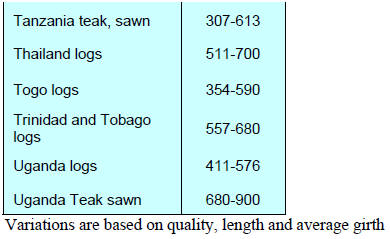
Prices for locally sawn hardwoods
Prices remain unchanged as increased imports of sawn
hardwoods have had a stabilising impact on the market.
On the other hand, sawmills utilising domestic logs are
finding it difficult to secure adequate supplies.
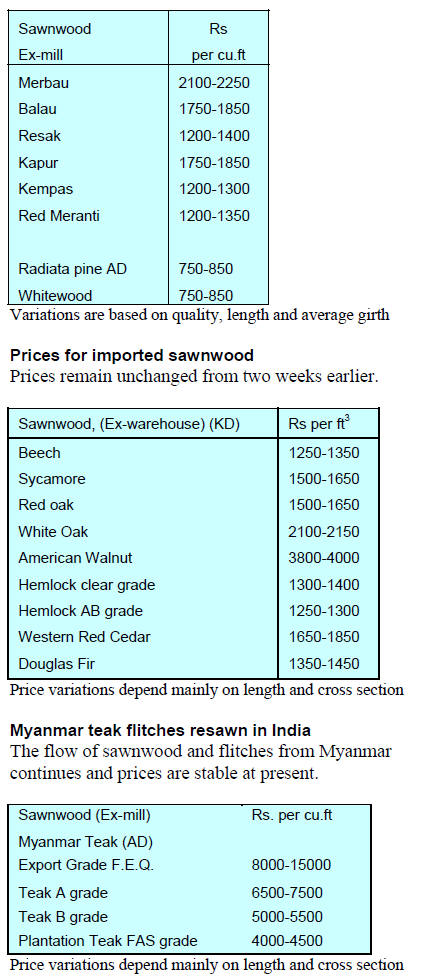
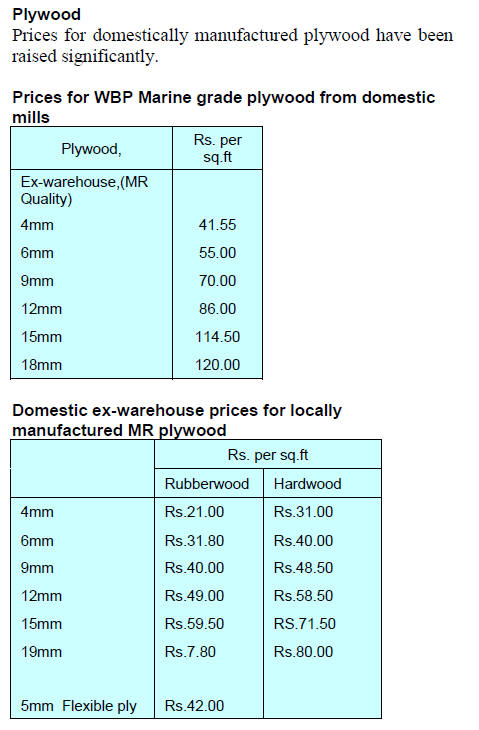
Mangrove institution first of its kind in India
The Maharashtra government has decided to establish a
Mangrove Conservation Institute, a dedicated body for the
conservation of mangroves across the state. In its latest
budget the state government allocated Rs.1150 million for
the new institute.
This will be first institution of its kind in the country
dedicated to the conservation of mangroves and will play
an important role in the protection and conservation of an
ecologically sensitive zone.
An action plan for conservation and protection as well as
the generation of employment opportunities and business
activities is proposed.
7.
BRAZIL
Australian red cedar has guaranteed
domestic market
Domestically grown Australian red cedar (Toona ciliate,
one of Australia's few native deciduous trees) is gaining
popularity in Brazil. This timber is also known as
toon or toona (also applied to other members of the genus
Toona), Australian red cedar, Burma cedar, Indian
cedar, Moulmein cedar and Queensland red cedar. It is
also sometimes called Indian mahogany.
Australian red cedar grown in Brazil has started to replace
high value native timbers such as Brazilian cedar (Cedrela
fissilis) and mahogany (Swietenia macrophylla).
The domestic market for sawnwood of around 25 million
cubic metres can readily absorb timber from plantation
thinnings of red cedar which can be used for fine finish
products in civil construction such as boards and batten
panelling, doors, windows and furniture. Logs can also be
used to produce decorative veneers.
Australian red cedar harvested at 15 years when trees are
over 50 cm in diameter. Thinnings of 8 year old cedar
generate an early financial return.
Reports suggest that thinnings from one hectare of
plantation can produce around 30 cu.m of sawnwood.
Currently, sawnwood produced from thinnings attracts a
price in the region of R$ 1,500 per cu.m.
One hectare of mature logs at the final harvest is said to
generate around 100 cu.m of sawnwood.
CIPEM and state representatives discuss coordinated
action to improve sector productivity
The state of Mato Grosso is one of the largest timber
producers from natural forests. The area under sustainable
forest management in the state is expected to increase
from 2.8 million ha. to 6 million ha. in the coming years
according to the Center for Timber Producers and
Exporters of the state of Mato Grosso (CIPEM).
At a recent meeting bringing together trade unions
associated with CIPEM and State government
representatives the need for coordinated action to improve
sector productivity was discussed. To achieve this
objective the State government proposed a partnership
with CIPEM so ways can be found to add value to
production from native forests.
First two months 2016 export performance
According to the Brazilian Tree Industry Association
(IBÁ), the volume of wood-based panels exported in the
first two months of 2016 amounted to 124,000 cu.m, a
70% increase over the same period last year.
Pulp exports grew to 2.2 million tonnes, a 25.6% increase
over the same period in 2015. On the other hand, paper
exports remained unchanged at 316,000 tonnes for January
and February 2016.
Total earnings from the export of wood-based panels, pulp
and paper in the first two months of 2016 amounted to
US$1.4 billion, a 19.7% increase compared to the same
period in 2015.
Pulp production reached 3 million tonnes for the two
months of January and February 2016, a 9.4% increase
year on year. The volume of paper production increased
1.4%, reaching 1.7 million tonnes compared to the same
period in 2015.
Domestic sales of wood-based panels totaled 961,000
cu.m in the first two months 2016, 8% lower compared to
the same period last year. First two months¡¯ domestic sales
of paper totalled 866,000 tonnes, 3.6% higher year on
year.
Brazil continues fight against plywood duty
The Brazilian Association of Mechanically-Processed
Timber Industry (ABIMCI) has consistently waged battle
with the US in recent years to remove tariffs on Brazilian
plywood.
ABIMCI has, once again, filed a formal petition with the
office of the United States Trade Representative asking for
a review the status of the Brazilian plywood within the
Generalized System of Preferences (GSP). Since 2005,
Brazilian softwood plywood exports to the US have
attracted an 8% duty which, says ABIMCI, undermines
the competitiveness of Brazilian plywood.
ABIMCI filed new petition at the beginning of April this
year with the US government requesting the re-designation
of Brazilian pine plywood within GSP. A similar
application was denied last year. ABIMCI says it filed the
petition again in order to promote fair competition among
market players.


8. PERU
Tackling illegal logging in Ucayali
Cesar Fourment Paredes, the High Commissioner for
Affairs to Combat Illegal Logging within the Council of
Ministers, has announced that his office will contribute to
the implementation and development of projects against
illegal harvesting in Ucayali.
He pointed to the need for design of a systematic
procedure involving indigenous communities who can
assist in monitoring forest operations. The Commissioner
said efforts will be made to contribute to the on-going
pilot projects in Ucayali run by the US based Rainforest
Foundation.
The Commissioner said support will be available for the
development of a multi-sectoral and intergovernmental
forest monitoring system utilising community skills and
the latest technologies. The project will harness the
knowledge of indigenous communities and satellite
imagery.
Geo-information for protected areas
At the beginning of this year the first early warning Geoinformation
(SAT-GI) project for protected areas was
launched. This project aims to counter illegal harvesting in
the Permanent Production Forests and Tambopata
National Reserve in Madre de Dios.
This system will utilise information from aero-optical
satellite imagery (Landsat, SENTINEL-2A) and radar
(Sentinel-1A, UAVSAR-NASA / JPL-Caltech).
Results will be sent directly to the Servicio Nacional de
Áreas Naturales por el Estado (SERNANP) for analysis of
changes in land use and of illegal harvesting. Reports will
be provided every 15 days if weather conditions are
favorable. It is expected that the methods adopted in this
initiative will have application in other areas threatened by
illegal activities.
Economy on sound footing, interest rates unchanged
in April
The Central Reserve Bank of Peru held interest rates
steady for a second consecutive month low inflation and a
strengthening of the domestic currency provided policy
makers with more flexibility.
The key interest rate was kept at 4.25% for April. In
announcing the decision to hold rates steady the Bank said
falling food and utility prices, a stronger Sol and positive
growth expectations meant a rate rise was not yet required.
See:
http://www.bcrp.gob.pe/docs/Transparencia/Notas-
Informativas/2016/LkdkT_dfkrk-re456ldl_yekdk-p34md.pdf
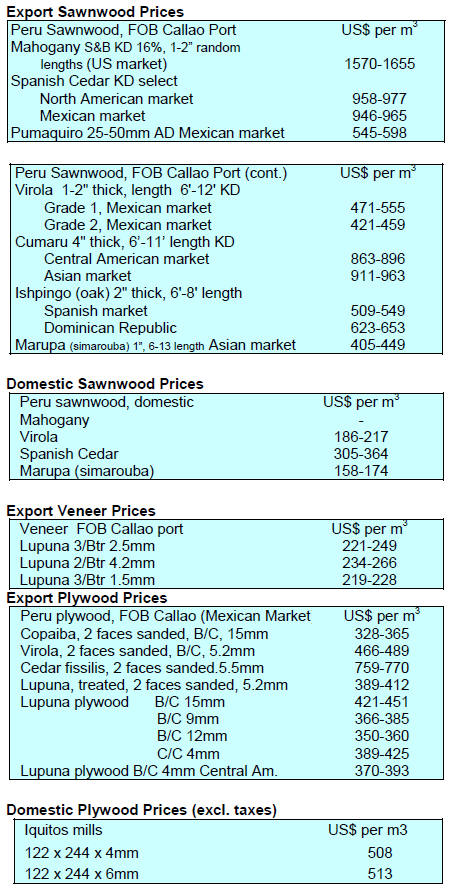
 NA
NA
